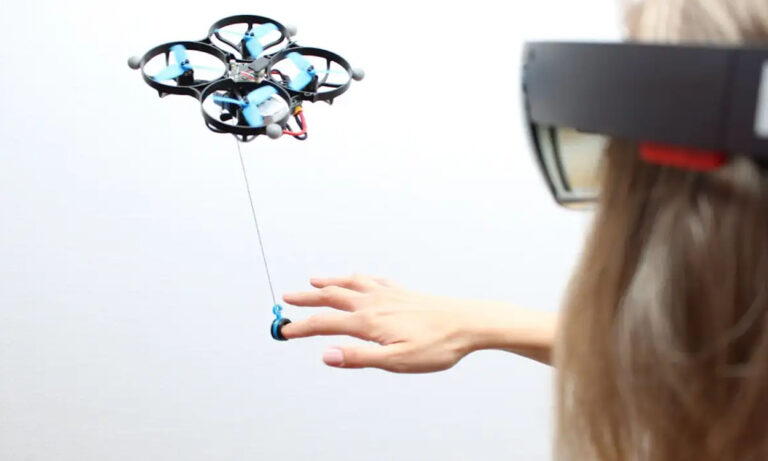Drones on strings could soon be used to puppeteer VR players into feeling virtual objects

From robotic virtual reality (VR) boots that allow players to walk without actually moving forward to the highly controversial NerveGear 2.0—a VR headset prototype that kills users if they die in a game—it’s safe to say that there have been countless tricks and gadgets released in recent years, all with the aim of making the simulated experience feel, well, less simulated.
In yet another attempt at improving just how real VR and augmented reality (AR) feel to users, Martin Feick at Saarland University in Germany and his colleagues have created HapictPuppet, a drone that uses ropes attached to a player’s fingers, wrists, or ankles to puppeteer them, in turn giving the purely virtual objects and environment a ‘physical’ tangible form.
Take pressing a button mid-air, for example—since AR allows users to still see the real world, researchers behind the new technology recommended designers opt for transparent polyamide thread in this specific situation.
VR or AR put aside, in both instances, as a user would be asked to press the button mid-air, the rope attached between their index finger and a small drone would be lifted in opposition to their movement—so lifting upwards as they press down on their virtual button—creating the illusion that they actually pushed down on something real since they felt some kind of resistance.
The same idea of fooling a user’s nerves into perceiving weight can pretty much be applied to any kind of movement they might be required to do while using a VR headset. Let’s say a player has to kick a ball, for example—using this puppeteer drone, they would feel the impact as their foot gets pulled in the opposite direction of where they hit the imaginary object.
Apart from its deployment in AR and VR, the HapticPuppet could also be a game-changer when it comes to rehabilitation and exercising as it would enable users to perform physical workouts with static or dynamically changing resistances. Compared to your standard resistance rehabilitation bands, in this case, only one device would be required—enabling a wide range of potential exercises that can be performed.
“Moreover, the airflow caused by the drones’ propellers, which is usually seen as one of the major drawbacks, may be utilised for active cooling of the person while exercising. This opens up an interesting design space that hopefully inspires future use cases,” the team of researchers explained in a summary of their study. When life gives you lemons, make lemonade, heh?
As noted in the study, precise positioning of the drones in a 3D space remains the key challenge for the current implementation of the technology. Imagine having to coordinate multiple drones simultaneously in a fairly small space, as well as the noise they make, and the fact that they could be potentially harmful to users.
To solve the latter, researchers explained that they “either want to use cages for the drones or even switch to blade-free drones in the future.” Considering the time when Enrique Iglesias cut his hand on a drone during a 2015 concert in Tijuana, it’s safe to say we expect Feick and his team to solve this minor problem any way they can.





